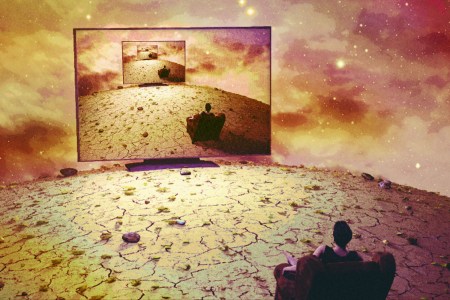In a celebrated episode of the original Star Trek series, a transporter malfunction sees the crew of the USS Enterprise swapped with dastardly counterparts. “Everything looks the same except they’re evil, and Spock has a goatee,” laughs James Kakalios, professor of physics at the University of Minnesota.
Where has the unexpectedly whiskered Vulcan come from? A parallel universe, of course. Back in 1967, Star Trek called this place a “mirror universe.” But thanks to a seemingly endless flow of sci-fi movies, books and video games over the last 20 years or more, most people — physicists included — now refer to the larger phenomenon as the “multiverse.”
“The ‘multiverse’ is a convenient and fun idea for sci-fi,” says Kakalios, author The Physics of Superheroes and a self-proclaimed comic-book aficionado. He notes that ancient mythologies and 19th-century fiction explored ideas of other universes long before science did. But, he adds, it is far from certain that the multiverse is anything more than a fun idea for sci-fi stories, a pop culture trope for our times. It’s also far from certain that some sort of multiverse doesn’t exist.
In scientific circles, the multiverse isn’t just an idea that, put in sci-fi terms, there are other versions of you living other versions of your life on other planets in other galaxies, or in alternate parallel dimensions somewhere. Rather, it’s a complex basket of theories, some riffing on each other, each as mind-blowing as the next — a bit of wave function and superposition here, a touch of string theory there, throw in some cosmic microwave background radiation, then add a touch of inflation — that have evolved over recent years, sparking heated debate as they’ve done so.
Revisiting the History of One Scientist’s Journeys Deep Into the Ocean
Brad Fox’s “The Bathysphere Book” chronicles an extraordinary voyageThere is, among them, a theory that has come to be known as the “many worlds” interpretation of quantum mechanics, first proposed — not without controversy among the few other scientists who paid it any attention — by physicist Hugh Everett in 1957. Quantum events, in which particles can be in multiple states at the same time, “collapse” on observation into one outcome. So what happens to the other outcomes? Everett proposed that these multiple states were also made real at the same time, somewhere, just unobserved to us. Branching endlessly, this in principal gives rise to an infinite number of universes, one of which might have branched off just now, another a billion years ago, each overlapping in dimensions we can’t access.
Then there’s the multiverse as seen through the lens of astrophysics. To simplify it, the already unimaginably gargantuan universe as we observe it is too smooth; there should be significant variations in energy levels as the universe expanded, post-Big Bang, but there aren’t. What’s called inflation — a theory of exponential expansion of space in the very early universe — has been proposed as the smoothing mechanism, and with it the idea that this inflation stopped just at the limits of our observation, but that other universes are infinitely inflating and expanding off of that. “Eternal inflation,” as it’s been described.
The physics we know here in our observable realm may not be the physics operating in other universes (in fact, we can’t even be sure that they’re operating in the farther reaches of our own). Some theories around this concept of inflation have one universe next to another universe, like expanding bubbles that occasionally collide with one another. Others say they’re forever expanding away from each other faster than the speed of light.
Well, nobody said this would be easy to grasp.
“Humanity has always been fascinated with ‘what if’ scenarios — the stories we tell about how things might have played out differently,” says theoretical astrophysicist and science communicator Ethan Siegel. “And given the state of the world over recent years, I think a lot of people have some craving for the escapism of imagining a different, better present, which seems a lot easier than thinking about how we might achieve a better future.”
“On the one hand, the ‘many worlds’ interpretation has played to that fascination, in the sense that it suggests that these different outcomes do occur. Not here, but in the infinite other universes that the quantum world permits,” he adds. “And on the other, the theory of cosmic inflation gives us this infinite unobservable universe out beyond our own, one that gives enough space to make it physically possible for there to be some place where, for example, everything turned out just as it did here up until this very moment but then took another turn towards a different outcome.”
“What’s important to note is that quantum physics is real. Cosmic inflation is real,” he says. “So the physical pillars [for thinking about the multiverse] are strong.”
“[Multiverse theories] are interesting ideas not because they’re ‘cool,’ but because they’re an attempt to solve unsolvable problems.”
James Kakalios, professor of physics at the University of Minnesota
But is there any way in which an interpretation of the multiverse makes sense? Try this. We can’t explain the features of our universe if there’s only one universe. For the emergence of life as we know it, the parameters of physics have to be so incredibly particular that the best explanation, some say, is that they are just the parameters that hold for the universe we happen to find ourselves in.
That, it’s suggested, only makes sense through three possibilities: by invoking a divine creator (not so scientific); by saying that current theories explaining the properties of our universe need radical revision; or, as bonkers as it might sound out loud, by concluding that there are countless other universes where the parameters are not right — if there is an infinite number of universes in which every possible permutation of parameters is accounted for.
“How come life is so good in our universe?” asks Kakalios. “There are all these different parameters we’ve measured that, if they were just a tiny bit different, the universe couldn’t have evolved as it has.”
Protons have the exact opposite charge, but about the same mass, as a neutron. Make the proton one percent larger, and life isn’t possible. If the energy that the sun generates when it fuses hydrogen together to make helium was 0.1% less, then there wouldn’t be planets. And so on.
“That’s some fine-tuning,” he says. “The multiverse picture says the parameters are different in other universes. We just happen to live in one where the numbers are right, and we wouldn’t be around to wonder about it otherwise.”
Enough With All the Multiverse Stories Already
How can there be any stakes in a show when there’s always the chance for a do-over?It’s an idea that Andrei Linde, professor of physics at Stanford University, and one of the authors of the idea of inflation, is convinced of. It explains, he says by way of example, why we exist in three dimensions plus time, and not string theory’s five or nine, because it’s only in four-dimensional space that the laws of electro-static interaction allow planetary bodies to be stable. He dismisses the notion proposed by the doubters that this takes us into the realm more of metaphysics or philosophy.
“We’re not talking here about the multiverse in terms of being some split reality in which you open some door and there you are again. That’s not the multiverse of physics,” Linde says, dismissing the sci-fi fun. Rather, he argues the reluctance among some physicists to accept the multiverse is more fundamental, a problem of human thinking.
“We need to learn to open our minds and be less chauvinistic, to separate physics from psychology and sociology,” says Linde. “But the problem is that we have a monotheistic tradition, so it’s just simpler to us to think that everything is the same everywhere — that the mass of electrons here is the same wherever you look. There’s this desire to reduce everything to one fundamental principle.”
“Even Einstein had the dream of finding a single unifying theory, and it’s that mindset that’s in all the textbooks still,” he adds. “Remember that inflationary theory is only 40 years old. But I think the genie is out of the bottle now. [The multiverse is] the theory that explains the facts that otherwise can’t be explained. Those that ignore it are just not ready to use the fact of their own existence as evidence.”
Ah, that word: evidence. Perhaps no other discussion in physics than that about the multiverse raises questions not just about the nature of reality, but the nature of the scientific method of observation, hypothesis, prediction, experiment and analysis. While Linde may point out that nobody can actually prove we live in the received model that is a singular, all-encompassing universe, nobody can prove we live in one among many universes — a multiverse — either.
“Science fiction is a mixed blessing because it’s interested in the ideas of the multiverse but has also promoted a lot of misconceptions, such that scientists have had to be conservative in their terminology so they don’t end up talking about parallel universes where Elvis is still alive.”
Paul Halpern, professor of physics at Saint Joseph’s University in Philadelphia
Avi Loeb, professor of science at Harvard University and author of Interstellar: The Search for Extraterrestrial Life and Our Future in the Stars, is not shy of serious scientific investigation of ideas that might be found outlandish by colleagues — not least that the first interstellar object to come within range of Earth’s telescopes, in 2017, was possibly of intelligent alien origin, given that it showed several properties that defied easy explanation. But he’s bothered by the lack of empirical substance in theories of the multiverse.
“I have an issue with concepts you can’t test experimentally because they’re not part of physics, which is about understanding the reality we all share,” Loeb insists. “The problem with the multiverse and its infinite number of options is that it just means anything you observe can be explained because anything can happen somewhere. You end up not constraining yourself by any empirical data. That may feel good. But how does that make it any different to religion, in which everything is possible?”
“It worries me a lot that hypothetical fantasies like the multiverse are gaining traction because, while there are a lot of unsolved problems in the reality we all share, I think it’s a lazy approach to work on something that can’t be tested, can’t be proven right, can’t be proven wrong,” he adds. “That’s a good way to impress your community of peers, but it’s not physics.”
Katie Mack, holder of the Hawking Chair in Cosmology at the Perimeter Institute in Waterloo, Canada, counters this way: surely you can have a theory about something we can’t observe that requires certain parameters for that theory to make sense.
“I mean, we talk about the wave function all the time, and it’s a necessary part of our theory [of quantum mechanics],” she says. “But you can’t observe it because doing so means it’s not a wave function anymore. You can say it’s not scientific because you can’t observe it, but that would be to undermine the entire mathematical structure of quantum mechanics.”
Kakalios jokes that the multiverse idea is like hanging a large picture to cover up a crack in the wall — it makes everything look good, but it doesn’t work out what’s causing the crack. But he’s also appreciative of the immense complexity of the questions being asked here.
“[Multiverse theories] are interesting ideas not because they’re ‘cool,’ but because they’re an attempt to solve unsolvable problems,” he suggests. These are problems, he adds, for which the naysayers are offering no alternative explanations.
“These are hard problems. Really nobody finds the idea of the multiverse completely satisfying because it’s untestable. It’s like saying the wizard did it,” he says. “But in science we don’t say, ‘I can’t explain this today, therefore it must be God.’ When we can’t explain something, we don’t throw up our arms — we roll up our sleeves [and get to working it out].”
He notes that Fermat’s Last Theorem, a theory in mathematics, took 300 years to be proved. Einstein predicted gravitational waves more than a century ago; instrumentation finally detected them in 2016. And then, thanks to Mr. Spock, Spiderman and the whole Marvel gang, there’s the double-edged sword that hangs over the layman’s modern interest in the idea of the multiverse.
“I think ideas like the multiverse are off-putting in part because they seem a lot like science fiction,” suggests Paul Halpern, professor of physics at Saint Joseph’s University in Philadelphia, and author of the forthcoming The Allure of the Multiverse: Extra Dimensions, Other Worlds, and Parallel Universes.
“Science fiction is a mixed blessing because it’s interested in the ideas of the multiverse but has also promoted a lot of misconceptions, such that scientists have had to be conservative in their terminology so they don’t end up talking about parallel universes where Elvis is still alive,” he says.
That’s ridiculous. As everyone knows, Elvis is still alive in our universe. We’re just waiting for proof.
Will the same proof come for the multiverse eventually? Or will other universes forever remain unreachable and undetectable to us — there in theory, but otherwise and by definition unknowable?
Some 15 years ago, a panel at Stanford was asked what they would bet on the multiverse being real. The cosmologist Martin Rees said he would almost bet his dog. Andrei Linde said he would almost bet his life. And the late Nobel Prize-winning physicist Steven Weinberg quipped that he would bet both Rees’s dog and Linde’s life. So what would James Kakalios bet?
“Well, I wouldn’t bet my copy of Fantastic Four #5,” he laughs. “Actually I might, but against it, because I really don’t think the multiverse is real and I think some other explanation will be found, though that may not be in my lifetime.”
This article appeared in an InsideHook newsletter. Sign up for free to get more on travel, wellness, style, drinking, and culture.

























